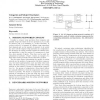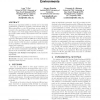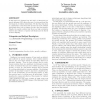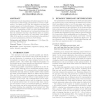82
Voted
GECCO
2005
Springer
15 years 6 months ago
2005
Springer
The identification of mechanisms by which constraints on phenotypic variability are tuned in nature, and the implementation of these mechanisms in Evolutionary Algorithms (EAs) ca...
92
Voted
GECCO
2005
Springer
2005
Springer
Providing information from the environment for growing electronic circuits through polymorphic gates
15 years 6 months ago
This paper deals with the evolutionary design of programs (constructors) that are able to create (n+2)-input circuits from n-input circuits. The growing circuits are composed of p...
59
Voted
GECCO
2005
Springer
15 years 6 months ago
2005
Springer
86
Voted
GECCO
2005
Springer
15 years 6 months ago
2005
Springer
We present a multi-objective evolutionary algorithm approach to the map-labelling problem. Map-labelling involves placing labels for sites onto a map such that the result is easy ...
96
Voted
GECCO
2005
Springer
15 years 6 months ago
2005
Springer
This paper presents an ant-based approach for solving the Traveling Salesman Problem (TSP). Novel concepts of this algorithm that distinguish it from the other heuristics are the ...
GECCO
2005
Springer
15 years 6 months ago
2005
Springer
Evolutionary algorithms (EAs) are widely used to deal with optimization problems in dynamic environments (DE) [3]. When using EAs to solve DE problems, we are usually interested i...
100
Voted
GECCO
2005
Springer
15 years 6 months ago
2005
Springer
In this paper we examine how the choice of functions in a genetic program (GP) affects the rate of code growth and the development of resilient individuals. We find that functio...
GECCO
2005
Springer
15 years 6 months ago
2005
Springer
This paper compares the performance of anti-noise methods, particularly probabilistic and re-sampling methods, using NSGA2. It then proposes a computationally less expensive appro...
85
Voted
GECCO
2005
Springer
15 years 6 months ago
2005
Springer
Evolutionary computation is used to construct undetectable computer attack scripts. Using a simulated operating system, we show that scripts can be evolved to cover their tracks a...
82
Voted
GECCO
2005
Springer
15 years 6 months ago
2005
Springer
Distributed Genetic Algorithms (DGAs) designed for the Internet have to take its high communication cost into consideration. For island model GAs, the migration topology has a maj...







